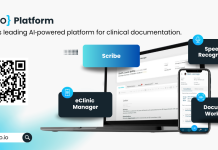David Littler from enChoice UK explains how utilising AI-powered Intelligent Document Processing (IDP) for unstructured data can improve government operations, enhance public services, and promote effective governance and public trust
Government agencies and public sector organisations manage vast amounts of unstructured data, including public records, legal documents, reports and correspondence. Without the right tools, this information remains siloed, limiting efficiency, compliance, and service delivery.
enChoice helps public sector organisations harness the power of their unstructured data through AI-driven Intelligent Document Processing (IDP). By following a structured content automation maturity journey, agencies can enhance accessibility, streamline workflows, and improve services.

The content automation maturity journey
This journey consists of four key stages: Accessibility, Acceleration, Automation, and AI. Each building upon the last to create a fully optimised, intelligent content ecosystem.
1. Accessibility: Digitising and organising public records
The first step in a digital transformation journey is ensuring information accessibility. Public sector organisations need to digitise paper-based records, classify and index information, and ensure it is securely available to authorised personnel. With increased digitisation, government employees can work more efficiently, and the public can access services more easily.
Many agencies still rely on outdated paper-based records or siloed digital files that are difficult to locate. These inefficiencies lead to delays in service delivery, compliance risks, and operational bottlenecks. By implementing robust capture and content management solutions, organisations can ensure that all content is properly categorised and readily accessible.
How accessibility supports government agencies
Secure content repositories digitise and securely store official records, reducing physical storage needs and improving compliance with record-keeping regulations. Integration with both internal business systems and external- facing services ensures consistent, secure access to documents across staff workflows and public touchpoints. Efficient search and retrieval enable employees to quickly locate and use critical records, improving overall efficiency and accelerating citizen service delivery.
2. Acceleration: Automating document capture and processing
Once records are digitised, public sector organisations can boost efficiency by automating data capture processes. AI-powered intelligent capture technologies minimise manual input, streamline data extraction, and enhance accuracy. This significantly reduces processing time, allowing agencies to focus on high-priority services and core public responsibilities instead of routine administrative work.
By automating repetitive tasks such as data entry, classification, and validation, public sector workers can reallocate their time to higher-value activities. Additionally, automation reduces the risk of human errors that can result in compliance violations or mismanagement of sensitive data.
How acceleration supports government agencies
Auto-classification and extraction using AI-driven document recognition eliminates manual sorting, reducing human errors and increasing processing speeds. Intelligent capture extracts key information from documents, reducing errors and improving response times by automating document intake and data validation.
Process optimisation reduces delays in public service workflows by eliminating reliance on paper-based processes, making government services more responsive and effective.
3. Automation: Enhancing government workflows
With intelligent capture in place, agencies can shift to automated processes that integrate with existing government applications, ensuring seamless information flow across departments. Automating administrative tasks, compliance tracking, and approvals allows agencies to optimise operations and improve inter-departmental collaboration.
Public sector agencies are often bound by strict regulatory requirements and complex workflows that involve multiple stakeholders. By using automation, these processes can be streamlined, ensuring compliance while improving overall service efficiency. For example, automating the routing and approval of documents accelerates decision-making and enhances transparency.
How automation supports government agencies
Workflow automation and decision support leverage process automation to streamline tasks such as approvals, compliance checks, and document routing. This reduces the time needed for manual processing and minimises human intervention.
Process modernisation redefines operations to become more efficient, transparent, and focused on citizens, resulting in quicker response times and enhanced service delivery. Integration with government systems employs microservices to connect with existing applications, allowing for modernisation without the need for a complete system overhaul. This approach helps agencies maximise the value of their current IT investments while also benefiting from advanced automation.
4. AI: Enabling smarter decision-making
The final stage of the journey is utilising AI and Machine Learning to transform data into actionable insights. By enabling contextual search, document summarisation, and predictive analytics, agencies can move toward proactive governance and data-driven decision-making.
AI can help agencies extract valuable insights from vast amounts of unstructured data, enabling public sector leaders to make informed decisions faster. By using AI-powered search, agencies can find relevant documents with ease, reducing administrative overhead. Additionally, AI can detect patterns in data, helping government organisations forecast trends, optimise resource allocation, and improve public services.
How AI supports government agencies
AI-powered search and discovery supports natural language processing (NLP) for fast and accurate information retrieval, enabling employees to find the right documents quickly.
Automated document summarisation uses AI to extract key insights from lengthy documents, reducing the time spent reviewing reports and increasing overall efficiency.
Predictive analytics and insights powered by AI help public sector leaders identify trends and optimise policy decisions, leading to better governance and improved resource allocation.
A future-ready public sector
As government agencies embrace digital transformation, intelligent document processing (IDP) is key to achieving greater efficiency, compliance, and public engagement. enChoice enables public sector organisations to seamlessly progress through the content automation maturity journey, ensuring that unstructured data is transformed into a valuable, easily accessible resource.
By adopting AI-driven automation and intelligent content management, agencies can reduce administrative costs, enhance compliance, improve citizen services, and make informed policy decisions to deliver more effective governance and public trust.
Let enChoice help you harness the power of AI and intelligent document processing to modernise public sector information management today.

This work is licensed under Creative Commons Attribution-NonCommercial-NoDerivatives 4.0 International.











